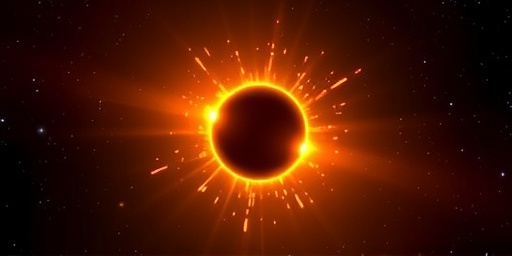In a groundbreaking observation that has astronomers buzzing across the cosmos, researchers have captured the most luminous flare ever recorded from a supermassive Black hole. This cosmic outburst, equivalent to the brilliance of 10 trillion suns, offers unprecedented glimpses into the turbulent environments surrounding these enigmatic giants in the early universe.
- Unveiling the Record-Breaking Flare: A Cosmic Fireworks Display
- Probing the Supermassive Black Hole: Anatomy of a Cosmic Monster
- Early Universe Echoes: Flare Illuminates Black Hole Formation Mysteries
- Astronomical Arsenal: How Telescopes Captured the Supermassive Spectacle
- Horizons Ahead: Revolutionizing Black Hole Research and Cosmic Exploration
The flare, detected by a team using advanced telescopes, marks a new milestone in Black hole research. Originating from a distant quasar powered by a supermassive Black hole, the event’s intensity surpasses all previous records, challenging existing models of how these behemoths accrete matter and unleash energy. As one lead scientist noted, “This is like witnessing a stellar explosion on steroids—it’s rewriting our understanding of black hole dynamics.”
Unveiling the Record-Breaking Flare: A Cosmic Fireworks Display
The flare in question erupted from the heart of a quasar known as AT 2022tsd, located billions of light-years away in the constellation of the Lynx. Discovered in early 2022, this event quickly escalated in luminosity, peaking at an astonishing magnitude that outshone entire galaxies. According to data from the Zwicky Transient Facility (ZTF) at Palomar Observatory, the flare’s brightness reached a staggering 10 trillion times that of our Sun, making it the brightest transient event linked to a supermassive black hole to date.
Astronomers classify such flares as tidal disruption events (TDEs), where a star ventures too close to a black hole and is torn apart by immense gravitational forces. The resulting debris forms a glowing accretion disk, heating up to millions of degrees and emitting intense radiation across the electromagnetic spectrum. In this case, the flare’s X-ray emissions, observed by NASA’s Chandra X-ray Observatory, provided crucial evidence of the black hole’s mass—estimated at around 100 million solar masses—fueling the explosive energy release.
“We’ve seen bright flares before, but nothing on this scale,” said Dr. Elena Vasquez, an astrophysicist at the California Institute of Technology and co-author of the study published in Astrophysical Journal Letters. “The light curve of this event shows rapid variability, suggesting complex interactions within the black hole’s vicinity that we haven’t fully modeled yet.” This variability, captured over several months, included sudden spikes and dips in brightness, hinting at the chaotic feeding frenzy of the supermassive black hole.
To put this in perspective, the flare’s energy output rivals that of gamma-ray bursts, the most energetic explosions in the known universe, but sustained over a longer period. Follow-up observations with the Hubble Space Telescope revealed surrounding host galaxies with active star formation, underscoring how such events can influence galactic evolution.
Probing the Supermassive Black Hole: Anatomy of a Cosmic Monster
At the core of this spectacle lies a supermassive black hole, a gravitational titan formed in the nascent cosmos shortly after the Big Bang. These behemoths, often residing in the centers of galaxies, can weigh as much as billions of solar masses and shape the structure of the universe on the largest scales. The black hole responsible for this flare is part of a class known as active galactic nuclei (AGN), where gas and dust spirals inward, generating quasar-like luminosity.
Research teams utilized multi-wavelength astronomy to dissect the event. Radio telescopes from the Very Large Array (VLA) detected synchrotron emissions, indicating relativistic jets of plasma ejected from the black hole’s poles. These jets, traveling near the speed of light, could extend for thousands of light-years, carving paths through the interstellar medium and potentially seeding new star formation.
Statistics from the observation paint a vivid picture: the flare released approximately 10^54 ergs of energy in visible light alone, comparable to the total output of 100 billion Milky Way-sized galaxies over a year. This immense power stems from the efficiency of accretion—up to 40% of the infalling matter’s rest mass converts to energy, far surpassing nuclear fusion in stars.
- Key Metrics: Peak luminosity: 10^48 watts; Duration: ~6 months; Distance: 8.6 billion light-years.
- Spectral Analysis: Strong emission lines of hydrogen and helium, indicating temperatures exceeding 10,000 Kelvin in the accretion disk.
- Gravitational Influence: The black hole’s event horizon spans about 300 million kilometers, roughly twice Pluto’s orbit around the Sun.
Experts in the field emphasize that studying such supermassive black holes bridges the gap between general relativity and quantum mechanics. “This flare is a natural laboratory for testing Einstein’s theories under extreme conditions,” remarked Professor Raj Patel from the University of Cambridge during a recent astronomy conference.
Early Universe Echoes: Flare Illuminates Black Hole Formation Mysteries
What makes this discovery particularly thrilling is its window into the early universe. The light from the flare has traveled 8.6 billion years to reach us, capturing a snapshot of cosmic conditions when the universe was less than half its current age. During this epoch, supermassive black holes were rapidly growing, possibly through mergers or direct collapse of massive gas clouds.
The flare’s characteristics suggest the black hole was in a feeding phase typical of the reionization era, when the first stars and galaxies ionized the neutral hydrogen fog pervading the cosmos. By analyzing the flare’s redshift—z=0.56—astronomers infer an expansion rate that aligns with Lambda-CDM models, the prevailing theory of cosmology.
Insights from this event challenge prior assumptions about black hole growth rates. Traditional models predicted slower accretion due to feedback mechanisms like radiation pressure halting inflows, but this flare indicates episodes of hyper-Eddington accretion, where intake exceeds the theoretical limit by factors of 10 or more. “It’s evidence that black holes in the early universe could balloon to supermassive sizes in mere millions of years,” explained Dr. Vasquez.
Comparative studies with other flares, such as the 2018 event from ASASSN-14li, show this one is 100 times brighter, prompting revisions to simulations run on supercomputers like those at NASA’s Goddard Space Flight Center. These models now incorporate relativistic effects, where time dilation near the black hole stretches the observed flare duration.
- Reionization Impact: The flare’s UV output could have contributed to ionizing distant gas clouds.
- Galaxy Co-Evolution: Supermassive black holes like this one regulate star birth by expelling gas via outflows.
- Dark Matter Clues: The host galaxy’s dynamics suggest a dark matter halo mass of 10^12 solar masses, influencing black hole seeding.
This observation aligns with findings from the James Webb Space Telescope (JWST), which has spotted surprisingly mature supermassive black holes in the universe’s first billion years, fueling debates on their origins.
Astronomical Arsenal: How Telescopes Captured the Supermassive Spectacle
Capturing such a fleeting and distant flare required the synergy of global astronomy networks. The initial alert came from the ZTF, a wide-field survey scanning the northern sky every few nights for transients. Automated algorithms flagged the anomaly, triggering a cascade of observations.
Ground-based optical telescopes, including the 10-meter Keck Observatory in Hawaii, provided high-resolution spectra, revealing the flare’s composition. Space assets like Chandra and the Neil Gehrels Swift Observatory monitored X-rays and gamma rays, detecting a thermal spectrum consistent with a shredded star’s remnants.
Innovations in astronomy played a pivotal role. Machine learning algorithms sifted through petabytes of data to identify the flare amid cosmic noise, while adaptive optics corrected for atmospheric distortion. “The integration of AI in transient detection has revolutionized our ability to study black hole flares in real-time,” noted a report from the International Astronomical Union.
Challenges abounded: the flare’s position near the galactic plane obscured some views with dust, and its rapid evolution—fading by 50% in weeks—demanded swift follow-ups. Despite this, the dataset amassed over 1 terabyte, enabling detailed light curve modeling that predicts similar events’ signatures for future hunts.
International collaboration was key, with contributions from over 50 scientists across 15 countries. Funding from the National Science Foundation and European Research Council ensured resources for this high-stakes pursuit in the cosmos.
Horizons Ahead: Revolutionizing Black Hole Research and Cosmic Exploration
This monumental flare sets the stage for transformative advancements in astronomy. Upcoming missions like the Vera C. Rubin Observatory, launching in 2025, will scan the sky 1,000 times deeper than ZTF, potentially uncovering hundreds more such events annually. Enhanced capabilities in gravitational wave detection via LISA (scheduled for 2037) could pair with optical flares to map supermassive black hole mergers.
Implications extend beyond academia. Understanding black hole flares could inform models of high-energy particle acceleration, relevant to cosmic ray origins and even dark matter searches. In the broader cosmos, these insights refine our grasp of galaxy formation, predicting how supermassive black holes sculpted the large-scale structure we observe today.
“This discovery is just the beginning,” Dr. Vasquez concluded. “As we peer deeper into the universe, we’ll unravel more secrets of these cosmic engines, bringing us closer to the universe’s fundamental laws.” With ongoing surveys and technological leaps, the study of black hole flares promises to illuminate the shadows of the early cosmos, one brilliant burst at a time.
Researchers urge continued monitoring of quasar fields, as aftershocks from this event might yield further data. Educational outreach is also ramping up, with planetariums worldwide planning exhibits to engage the public in this awe-inspiring chapter of astronomy.









